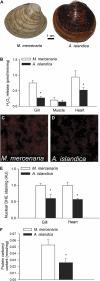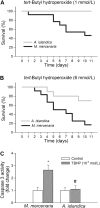Extreme longevity is associated with increased resistance to oxidative stress in Arctica islandica, the longest-living non-colonial animal
- PMID: 21486920
- PMCID: PMC3143345
- DOI: 10.1093/gerona/glr044
Extreme longevity is associated with increased resistance to oxidative stress in Arctica islandica, the longest-living non-colonial animal
Abstract
We assess whether reactive oxygen species production and resistance to oxidative stress might be causally involved in the exceptional longevity exhibited by the ocean quahog Arctica islandica. We tested this hypothesis by comparing reactive oxygen species production, resistance to oxidative stress, antioxidant defenses, and protein damage elimination processes in long-lived A islandica with the shorter-lived hard clam, Mercenaria mercenaria. We compared baseline biochemical profiles, age-related changes, and responses to exposure to the oxidative stressor tert-butyl hydroperoxide (TBHP). Our data support the premise that extreme longevity in A islandica is associated with an attenuated cellular reactive oxygen species production. The observation of reduced protein carbonyl concentration in A islandica gill tissue compared with M mercenaria suggests that reduced reactive oxygen species production in long-living bivalves is associated with lower levels of accumulated macromolecular damage, suggesting cellular redox homeostasis may determine life span. Resistance to aging at the organismal level is often reflected in resistance to oxidative stressors at the cellular level. Following TBHP exposure, we observed not only an association between longevity and resistance to oxidative stress-induced mortality but also marked resistance to oxidative stress-induced cell death in the longer-living bivalves. Contrary to some expectations from the oxidative stress hypothesis, we observed that A islandica exhibited neither greater antioxidant capacities nor specific activities than in M mercenaria nor a more pronounced homeostatic antioxidant response following TBHP exposure. The study also failed to provide support for the exceptional longevity of A islandica being associated with enhanced protein recycling. Our findings demonstrate an association between longevity and resistance to oxidative stress-induced cell death in A islandica, consistent with the oxidative stress hypothesis of aging and provide justification for detailed evaluation of pathways involving repair of free radical-mediated macromolecular damage and regulation of apoptosis in the world's longest-living non-colonial animal.
Figures






References
-
- Harman D. The biologic clock: the mitochondria? J Am Geriatr Soc. 1972;20:145–147. - PubMed
-
- Harman D. Aging: a theory based on free radical and radiation chemistry. J Gerontol. 1956;11:298–300. - PubMed
-
- Sentman ML, Granstrom M, Jakobson H, Reaume A, Basu S, Marklund SL. Phenotypes of mice lacking extracellular superoxide dismutase and copper- and zinc-containing superoxide dismutase. J Biol Chem. 2006;281:6904–6909. - PubMed
Publication types
MeSH terms
Substances
Grants and funding
LinkOut - more resources
Full Text Sources
Medical

